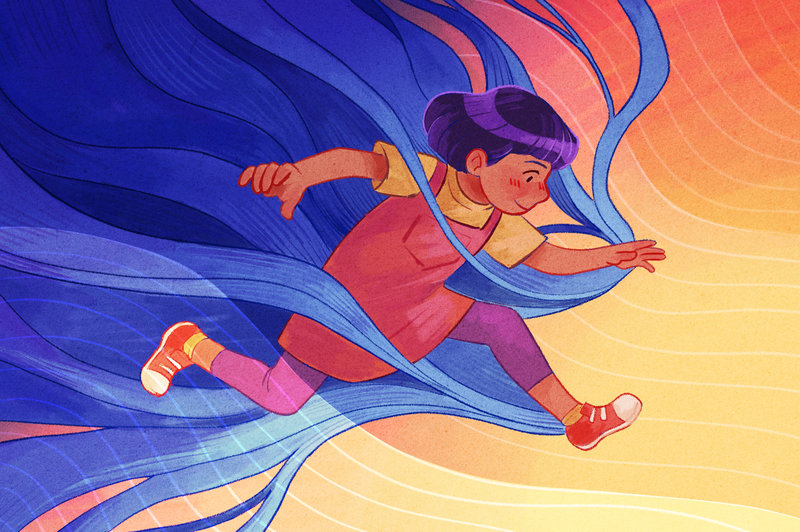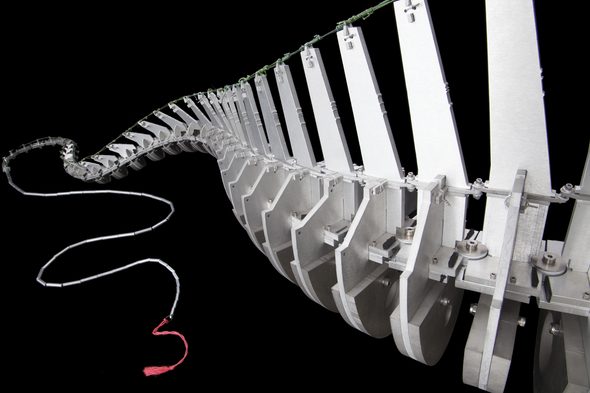KAVITHA CARDOZA, HOST: I’m Kavitha Cardoza, and this is NPR’s LIFE KIT.
(SOUNDBITE OF MUSIC)
CARDOZA: Watching a child deal with anxiety is tough. It’s tempting to focus on wanting to make that anxiety go away.
RENEE JAIN: When we were approached to write a book on anxiety, they actually asked us to write a book about trying to get rid of it for kids. And we told them that we have a different take on it – that this is part of us, so it’s not about getting rid of it; it’s about transforming.
CARDOZA: That’s Renee Jain. She’s the founder of GoZen! She and her coauthor, Shefali Tsabary, wanted to take a different approach to kids and anxiety when they were writing a book on the topic.
JAIN: We wanted to really take it head-on and normalize it and really get kids to embrace it, which sounds strange to most parents and most kids when they first hear that.
CARDOZA: Their book, “Superpowered: Transform Anxiety Into Courage, Confidence, And Resilience,” helps children change their relationship with anxiety rather than change the anxiety itself, a radical idea, they say, in a society that tries to ignore hard feelings.
SHEFALI TSABARY: It’s revolutionary to feel your feelings in today’s world, and that’s really a tragedy.
CARDOZA: Shefali and Renee explain that all children are born with five superpowers, superpowers that are key to reframing anxiety. The problem is that children lose these superpowers as they get older. But they can take them back. While the reading age for their book is technically 8 to 12…
JAIN: We have seen from the feedback that we’re getting from people who are buying it and reading it with their kids, it really is for all ages.
CARDOZA: So on this episode of LIFE KIT, how to get your superpowers back and see anxiety as part of our humanity rather than something to get rid of.
(SOUNDBITE OF MUSIC)
CARDOZA: I love the premise of the book – that all children are born with five incredible superpowers. So superpower one, for example, is all kids were born explorers. They start out wanting to touch and smell and watch everything. Tell me about some of the other superpowers.
JAIN: Yeah. So we have presence, as you mentioned. And we have – O is originality, right? We come into the world owning this incredibly original voice. Then we have W, which is whole, right? You are enough as you are in this moment, no matter what. Often, we feel we need to reach a goal or, you know, get a certain accolade or get a trophy or a grade in order to feel like, well, if I do this, then I’m going to feel happy. And we are fiercely reactivating the superpower in kids and telling them, no, you’re amazingly whole as you are. The E is for energized. You know, all kids come into the world with incredible amount of energy at their disposal – jumping out of bed, ready to, you know, attack the day and the world.
And resilience – you know, we’ve rarely met a kid who has the ability – if they have the ability to walk, they will try a thousand times. They will fall, and they will get up. And they will fall, and they will get up, and they will fall. And they don’t stand up and say – you know what? – I’m just not – I’m not going to do this walking thing. Forget it. Forget it. Right? They’re like – we come in resilient. We want to master our skills and model the other people in the world around us.
CARDOZA: So give me some examples of how children lose their superpowers, or the way y’all put it is, how do those superpowers get zapped?
TSABARY: In the book, we talk about – one way we do it is through should-ifying. You know, we should. Everything is the should – how things should be, how my kids should be, how you should feel. But we miss how they are, you know? So it’s moving away from the fantasy and the expectation to the reality and meeting your kid where they are in the moment. So one of the ways it gets zapped is through this incessant future-based kind of should-ifying that we do and living in another time zone rather than the acceptance of the present moment.
JAIN: Yeah, absolutely. As parents, we really – we usher this as well. We facilitate getting stuck in the future. Well, you know, you really have to study for this math test ’cause math – that math test will then relate to whether you get into the good math class, which is then a good college, which is then a good career and a good husband or wife or mate. And so we play the whole thing out in a simulation. And that’s OK if we’re making plans, but we need to be able to bring ourselves back into the moment so that we can actually live our lives – right? – and not obsess about everything that could possibly happen in the future.
CARDOZA: One of the things adults often say to kids and to each other is, don’t worry. And both of you believe dismissing worry isn’t a good idea, right? In fact, you believe worry has purpose, worry has benefits, worry is good for you.
JAIN: Yes. You know, the funny thing about a parent saying to a child, don’t worry, is, obviously, it’s coming from love, often great intention, and you really know from experience that there may be nothing to worry about. But the issue with doing that is that you are not giving the child or the tween or the teen the ability to do this for themselves.
So what we introduce in the book is a character named Wisteria the Warrior (ph), and we call her Wisty for short. So when you are able to take a feeling that can be abstract and hard to wrap your head around and you create a character and you personify it, that makes it concrete for kids. And what it has them do is know that this character is a part of who you are, but it’s not all of who you are. And also, you are able to begin a friendship and a dialogue with this piece of yourself, with anxiety. The primary thing that we want you to do is to cultivate a relationship with this anxiety and start to talk to it.
CARDOZA: Give me an example of how that would play out. How would you have a dialogue with worry?
TSABARY: You can write in a journal. That’s one form of literary personification. Just writing the words of how you feel allows that distance and that space and that perspective. Draw a character. Draw a picture. Give it a name. Give it a tone. Give it a color. What would it say right now? Make a puppet out of a sock. Talk to it. I’ll be it. You be it, right? Any time you can do that, it demystifies this otherwise ominous kind of feeling to really, you know, demystifying and allowing you to simplify this otherwise threatening world that’s inside that everyone seems to be running away from.
CARDOZA: Some of the exercises focus on helping kids understand the whole picture. And the exercises are super practical. So, for example, you have one called What’s Under The Duck? And it helps kids understand that the duck kind of looks like it’s serenely floating by, but under the water, it’s paddling furiously. Can you talk about some other practical ways that children can help themselves?
JAIN: Yeah. The best-case, worst-case scenario exercise that’s in the book is really to kick-start your ability to assess risk. So when you are talking to a kid or you’re talking to a teen and they are feeling really anxious, what happens is that their ability to assess risk is kind of thrown out the door. So maybe they’re afraid to fly in a plane, and you say to them – but you know what? – you go in a car every day, and statistically, that’s actually more dangerous than flying in a plane. Well, they might say, don’t really care; I feel like it’s more dangerous to go in a plane. And so their feelings really start to overpower their ability to assess the risk.
So if you write down what’s the best thing that can happen or the best-case scenario, what’s the worst case, and what’s the most likely outcome, what that do – what’s that doing for you? It is helping you to, you know, again, start that engine in your mind where you can assess probability.
CARDOZA: So let’s talk about ways kids can get back their superpowers. So one of the ways you can be present is by becoming a noticer.
TSABARY: So one of the ways that we return them to that practice, their own sense of mindfulness is by teaching them to learn to observe, you know? And adults need to learn this as well, where you learn to notice – notice what kinds of thoughts are coming, you know? And teaching children that just because they have a thought doesn’t mean they need to react to the thought – and this is for adults as well – is probably one of the most powerful things we can teach ourselves and them because once you realize that a thought doesn’t have power over you and that you can literally just observe it and let it pass, you then decide which thoughts you wish to choose to react to, choose to respond to. And just giving children that baton that you’re in charge of which thoughts you wish to respond to, you choose to respond to is a huge empowering technique that we can all benefit from, but especially children.
CARDOZA: Being whole – how do you get that back?
TSABARY: Wholeness is something children come to the world with, where they feel very connected to who it is they are. They don’t see anything wrong with them. They don’t believe they need to change something about them. But very quickly, within the first two years, they quickly pick up that who I am is not being accepted, so I need to tweak myself. I need to change parts of who I am. And like, you know, an ever-moving jigsaw puzzle, they’re trying to recreate a new version of themselves because they’re trying to fit in, and this takes away from their wholeness.
So in the book, we talk about how to move from that desire to fit in to a new desire, which is to be connected and to belong to oneself. And one of the exercises here is how do you – teaching children how to move from the anxiety of, everything is wrong with me, to shifting that to a celebration. And one of the exercises here is use your supervision glasses, where you put on a new vision of who it is you are.
So if you are thinking, oh, my goodness, I’m just so weird – you know? – I overthink everything, or I can’t do anything right, you put on these glasses, which changes your perspective about who it is you are. And you say – instead of beating yourself down to saying, you know, I’m such a creative person. That’s why I have so many ideas. I’m not overthinking. I’m overcreative. So in ways like this, we teach children, stop trying to become something you’re not, and shift into realizing the potential of all that you already are.
CARDOZA: Another superpower that gets zapped is feeling energized. How do you get that back?
JAIN: One of the concepts that we talk about it in this chapter of getting that superpower back is finding your flow. When you are in a state of flow or in the zone, as they might call it – we’ve all been there before, that place where you’re writing or you’re painting or you’re cooking or you’re doing something where you’re so immersed that all time falls away. So the – one of the best ways to reactivate the superpower is to find your kids, observe them in flow. Let’s find where are they in flow. Maybe it’s video games. You know, maybe it’s playing basketball. Maybe it’s when they’re singing. And find the elements that are creating the flow. See why, right? Let’s look at the why of those elements are working for them and talk to them about it – right? – and see if you can recreate some of those in their life.
CARDOZA: So the last one comes up a lot in all kinds of issues about children, the superpower of resilience.
TSABARY: You know, we are raising children with this fixed mindset versus a growth mindset because we adults are fixed in our fixed mindset of duality – you know, positive or negative, success or failure, good or bad. And these fixed ways of looking at the world peg us down and paralyze us. And that’s what we’ve done to our children. So this chapter teaches parents really, first, to have a fluid mindset to move from this fixed I can’t do it to I’m still learning mindset, which is growth based.
CARDOZA: So it’s not the destination. It’s the journey.
TSABARY: Yeah, but this is a culture that is so obsessed with only the final letter grade, the final bank account, the final look. And that’s why children lose resilience. They just don’t want to try anymore. And resilience is the opposite of that. Resilience is the capacity to keep going despite the odds because you have this inner optimism of courage or hope or this tolerance for risk.
JAIN: A lot of people are familiar with Carol Dweck’s work on growth and fixed mindset. And they will – in classrooms, they’ll hang up posters that say, don’t write I can’t do it. Write I can’t do it yet, right? And we feel that language is, like, going to get us there. And language is amazing and mindset is amazing, but the ability to change takes action and it takes a habit. So we leave this book off on mindset, but it is literally the beginning of positive change in a child’s life. The only way to actually have it be a part – a deep embedded part of their life is for them to begin to act upon their belief system.
CARDOZA: That’s actually kind of – was kind of my last question, that I was struck by how practical this book was. You know, it seemed like you had to do stuff. It wasn’t just, oh, I’m going to read about stuff.
TSABARY: Yeah. And the deeper implication of that is really vast and a rippling effect, which is you’re not fated, you know, to your culture, to your indoctrination, to your traditions or the present-day reality. You can be the master and mistress of your own inner state of joy. So take the helm. You know, we’re giving children that power. Don’t wait for your parents, don’t wait for culture, don’t wait for your teachers. You can wake yourself up and live your best, most joyful life. It’s your inner terrain that is in your control. And we give them that sense of empowerment, which is really the key to the whole book.
(SOUNDBITE OF MUSIC)
CARDOZA: That’s clinical psychologist Dr. Shefali Tsabary and Renee Jain, the founder of GoZen! They are the co-authors of “Superpowered: Transform Anxiety Into Courage, Confidence, And Resilience.”
(SOUNDBITE OF MUSIC)
CARDOZA: So let’s recap. Make friends with the worry. Telling children not to worry isn’t helpful. Instead, try personifying the anxiety.
JAIN: So when you are able to take a feeling that can be abstract and hard to wrap your head around and you create a character and you personify it, that makes it concrete for kids.
CARDOZA: Encourage mindfulness. Help children notice the thoughts in their minds, but recognize they have the choice to accept the thought or not.
TSABARY: Once you realize that a thought doesn’t have power over you and that you can literally just observe it and let it pass, you then decide which thoughts you wish to choose to react to, choose to respond to.
CARDOZA: Rediscover flow. Notice when your kids are in a flow state. Is it when they’re playing basketball or reading or baking? Recognize the state in your kids and help them recreate those aspects in other parts of their life.
A growth mindset will promote resiliency. Help children overcome challenges by promoting encouraging language. So instead of I can’t do this, say I can’t do it yet. But remember, a growth mindset is just the beginning. Change takes action and habit. Help children act upon these beliefs.
(SOUNDBITE OF MUSIC)
CARDOZA: For more episodes of LIFE KIT, go to npr.org/lifekit. We have episodes on all sorts of topics, from how to start therapy to how to compost at home. Also, we want to hear your random tips. Leave us a voicemail at 202-216-9823 or email us at lifekit@npr.org. This episode was produced by Clare Marie Schneider. Meghan Keane is the managing producer, and Beth Donovan is our senior editor. I’m Kavitha Cardoza. Thanks for listening.















